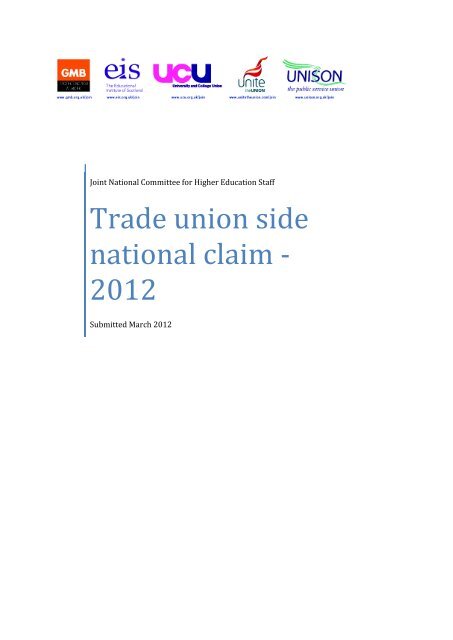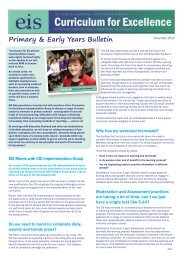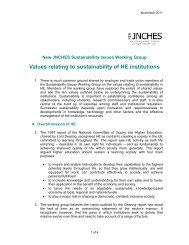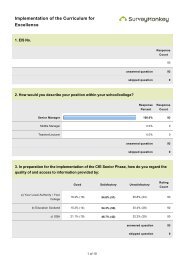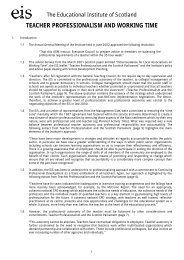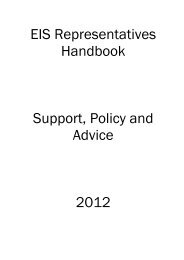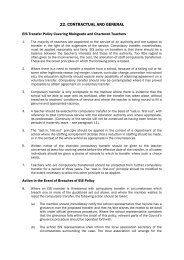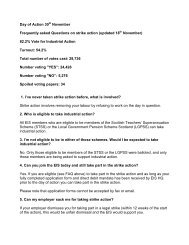download full PDF Document here - The Educational Institute of ...
download full PDF Document here - The Educational Institute of ...
download full PDF Document here - The Educational Institute of ...
Create successful ePaper yourself
Turn your PDF publications into a flip-book with our unique Google optimized e-Paper software.
Joint National Committee for Higher Education StaffTrade union sidenational claim -2012Submitted March 2012
Trade Union ClaimThis claim is submitted jointly on behalf <strong>of</strong> the higher education trade unions. <strong>The</strong>claim is submitted against a background <strong>of</strong> continuing high inflation and that since2009 the New JNCHES national bargaining process has delivered a low or belowinflation pay award.<strong>The</strong> effect <strong>of</strong> this is that across the higher education workforce, staff are reportingreal falls in income and difficulties in maintaining their standards <strong>of</strong> living.It is also the view <strong>of</strong> the trade union side that since the introduction <strong>of</strong> New JNCHES,the employer’s side has deliberately restricted the scope <strong>of</strong> bargaining.This claim seeks to redress this. <strong>The</strong> trade unions are seeking in 2012/13:An increase <strong>of</strong> 3.7% on all salary points to match the increase in RPI toFebruary 2012A further increase <strong>of</strong> 3.3% to begin to catch up with the real terms cut in payover the last three yearsA commitment from all universities to pay a ‘Living Wage’Positive proposals from employers to address the outstandingrecommendations <strong>of</strong> the 2009/10 Equalities Working Group. In particular, weare seeking positive action to address the continuing gender pay gap in hig<strong>here</strong>ducation.Joint proposals on pay equality for pr<strong>of</strong>essors and senior staffStructural proposals on the assimilation <strong>of</strong> hourly paid staff to the national payspine and transfer to fractional contractsA joint agreement on disability leavePay and InflationFor most staff the increase in pay over the last three settlements has amounted toapproximately 1.4%. During the same period, the RPI index has increased by over12%, resulting in a real terms cut <strong>of</strong> over 10% in the value <strong>of</strong> take home pay for staff.For example, between August 2009 and July 2011 someone on pay point 22 willhave lost over £1,600 in real terms. Someone on pay point 43 will be nearly £3,000worse <strong>of</strong>f.
Pay Spine Point Total Shortfall Aug 2008– July 20111 £ 10115 £ 111915 £ 147522 £ 160129 £ 196934 £ 228236 £ 242243 £ 297949 £ 355651 £ 3773Whist the increase in the rate <strong>of</strong> inflation may be falling slightly in 2012 as theincrease in VAT drops out <strong>of</strong> the headline rate, the impact <strong>of</strong> increased costs on staffremains. RPI is expected to remain above 3% for the remainder <strong>of</strong> 2012 and abovethe Bank <strong>of</strong> England target <strong>of</strong> 2% in 2013. T<strong>here</strong>fore a significant increase on allsalary points is required simply for staff to stand still.For lower paid staff the impact <strong>of</strong> inflation has a far deeper effect. <strong>The</strong> cost <strong>of</strong>essential goods such as food, fuel and energy have increased at an even higher ratethan general inflation and with less disposable income, many lower paid staff arestruggling to make ends meet.Pay settlements in the private sector are returning to pre-recession levels. IDSanalysis <strong>of</strong> settlements in the last quarter <strong>of</strong> 2011 showed 59% <strong>of</strong> settlements wereabove 3% and 28% <strong>of</strong> settlements were above 4%. <strong>The</strong> median settlement was 3%.Annual Changes in RPI by Quarter 2010/2012January 2010 3.7%April 2010 5.3%July 2010 4.8%October 2010 4.5%January 2011 5.5%April 2011 5.2%July 2011 5.0%October 2011 5.4%January 2012 3.9%February 2012 3.7%Source: Office for National Statistics http://www.ons.gov.uk/ons/key-figures/index.html
All-items RPI forecast, average 2012 20132012 2013January 2.7%February 3.7% 2.6%March 3.7% 2.6%April 3.4% 2.6%May 3.5% 2.5%June 3.6% 2.5%July 3.6%August 3.4%September 2.9%October 3.0%November 3.0%December 2.9%Source: IDS Pay Report 1088, January 2012London Weighting<strong>The</strong> level <strong>of</strong> London weighting paid in universities remains among the lowest acrossthe public sector. <strong>The</strong> most common rate <strong>of</strong> £2,134 paid in pre-1992 universities isthe lowest <strong>of</strong> all. <strong>The</strong> cost <strong>of</strong> living in London and average salaries in London aresignificantly higher than in other parts <strong>of</strong> the country.<strong>The</strong> higher education unions have consistently sought a rate <strong>of</strong> £4,000 for InnerLondon weighting to bring universities more in line with other employers and to pay arate that reflects the true cost <strong>of</strong> living in London.Pension IncreasesChanges to public sector pensions will see further increases in employeecontributions to schemes. This will result in further reductions in the take home pay<strong>of</strong> staff. Staff in the USS have already seen an increase <strong>of</strong> 1.15% in contributionsand staff in the NITPS, STSS and the TPS will see increases <strong>of</strong> between 0.6% and2.4% <strong>of</strong> pay from April 2012. Proposals are also expected shortly for members <strong>of</strong> theLGPS that is likely to see increases in contributions for many staff. <strong>The</strong>se increaseswill have the impact <strong>of</strong> further reducing take home pay for staff.Affordability<strong>The</strong> Hefce report, ‘Financial health <strong>of</strong> the higher education sector’ published inMarch 2012 reported that, ‘the majority <strong>of</strong> the key financial indicators are the best onrecord, with the sector reporting strong surpluses, large cash balances and healthyreserve levels.’ <strong>The</strong>y also state that the financial outcomes reported for 2010/11 aremuch stronger than the sector’s forecast for the year.<strong>The</strong> report identified that operating surpluses increased from £708m (3.2% <strong>of</strong>income) in 2009/10 to £1,062m (4.6% <strong>of</strong> income) in 2010/11, against a long term
average <strong>of</strong> 2.7%. <strong>The</strong> percentage <strong>of</strong> staff costs as a percentage <strong>of</strong> income fell from54.3% to 53% in the same period; a historical low. <strong>The</strong> report also identifiedincreases in cash flow levels, liquidity and reserves <strong>of</strong> universities.This healthy financial position is reinforced when falling staff costs as a percentage<strong>of</strong> total expenditure in the period is considered. This has fallen from 57.4% in 2007/8to 56.2% in 2010/11.Staff costs as % total expenditure2007/8 57.4%2008/9 56.8%2009/10 56.6%2010/11 56.2%Source: HESA, Resources <strong>of</strong> Higher Education Institutions, HESA HE Finance Plus, series; %calculation UCUIncome across the sector rose by 3.2%, income from student fees rose by 8.5% andincome from overseas students increased by 16%. At the same time the staff costsfell by 2%. <strong>The</strong> report identified a real term reduction in average pay in the sector.<strong>The</strong> key concern <strong>of</strong> institutions in the identification <strong>of</strong> future risk was a fall in studentnumbers. <strong>The</strong> report states that UCAS indicate that student demand for places in2011/12 continued to exceed supply and that the risk <strong>of</strong> an unexpected drop instudent number in 2012/13 is low.<strong>The</strong> report identifies that income from student fees will continue to increase, morethan <strong>of</strong>fsetting reductions in teaching grants and research funding allocations. Hefcehave predicted that the income for teaching will increase by almost 8% from £8.9bthis year to £9.6b in 2014.<strong>The</strong> Scottish Government has published its three year funding allocation for theUniversity Programme Budget. <strong>The</strong> allocation <strong>of</strong> funding to universities will increaseby over 14% in this period, rising from £926.6m in 2010/11 to £1061.7m in 2014/15.<strong>The</strong> Scottish Government has also agreed to continue funding undergraduateteaching <strong>of</strong> Scottish domiciled and EU students.Affordability <strong>of</strong> pay increases hasn’t been an issue for all staff in HE in recent years.HESA data shows that pay for Vice-chancellors has increased at almost double therate <strong>of</strong> other staff groups since 2002 and that the number <strong>of</strong> staff earning over£100,000 in higher education has increased to over 1,300.<strong>The</strong> Living Wage<strong>The</strong> Joint Higher Education Unions are seeking a commitment from all hig<strong>here</strong>ducation institutions to pay a ‘living wage’. A ‘living wage’ is defined as a wageproviding ‘a minimum acceptable quality <strong>of</strong> life to enable people and their families tolive decently within their community.’
<strong>The</strong> widely accepted living wage outside London is £7.20 per hour. This is the figureused by the Living Wage Foundation based on research by the Joseph RowntreeFoundation and the Centre for Research in Social Policy at LoughboroughUniversity. <strong>The</strong> living wage in London is £8.30 per hour. This is determined by theLiving Wage Unit at the Greater London Authority.<strong>The</strong> current minimum hourly rate for staff in the higher education sector on thenational pay spine is £6.92 for staff on point 1 and a 37 hour working week. It wouldrequire a 4% rise for these staff to be paid at the current rate <strong>of</strong> the living wage. InLondon many institutions fail to match the living wage because they pay some <strong>of</strong> thelowest rates <strong>of</strong> London weighting <strong>of</strong> any public bodies.<strong>The</strong> unions are seeking a commitment from employers to pay a living wage not justin 2012, but also for the years ahead. We are also seeking a commitment fromuniversities that staff that are contracted out are also paid a living wage.<strong>The</strong> living wage is already in place in many public and private sector employers. InLondon thirteen universities have committed to paying a living wage to all staff. Forthe significant percentage <strong>of</strong> institutions that operate a 35 hour working week t<strong>here</strong>would also be no cost.For many institutions the cost would be minimal. Indeed, many employers havestated that they have benefitted from paying a living wage. As well as enhancing t<strong>here</strong>putation <strong>of</strong> the employer, employers have seen retention and productivity rates riseand sickness levels fall as staff feel more valued and no longer have to take on twoor three additional jobs to make ends meet.A representative <strong>of</strong> one <strong>of</strong> the UK’s leading banks said that, ‘since adopting theLondon Living Wage in 2007 the company has seen catering staff retention ratesincrease to 77% compared to an industry norm <strong>of</strong> 54%, and cleaning staff retentionrates climb to 92% compared to the industry norm <strong>of</strong> 35%.’ This has saved time andmoney not only in recruitment and selection costs but in training and productivity.Last year the further education employers committed to a living wage for all. Acommitment to pay a living wage is rapidly becoming a mark <strong>of</strong> a good and sociallyresponsible employer within a community. This is precisely how higher educationinstitutions should be viewed and we would welcome a positive response to thisclaim.EqualitiesDespite improvements in recent years, the gender pay gap in higher education is stillmuch greater than in the wider economy and across the public sector. <strong>The</strong> JNCHESEquality Working Group identified that the HE <strong>full</strong> time gender pay gap was 17.3%compared to a UK workforce average <strong>of</strong> 10.2%. <strong>The</strong> pay gap for female academicstaff was 13%.<strong>The</strong> gender pay gap for higher education teaching pr<strong>of</strong>essionals identified by ASHEin 2000 was 15%. This had dropped a miniscule amount to 14.4% in 2011. Progress
on this issue has been woe<strong>full</strong>y slow. <strong>The</strong> gender pay gap for teaching staff in hig<strong>here</strong>ducation is substantially higher than in other areas <strong>of</strong> the teaching pr<strong>of</strong>ession.Gender pay gap in the UK teaching pr<strong>of</strong>ession, 2011 (ASHE)Female£ Male £F as %MGenderpay gap*Higher education teachingpr<strong>of</strong>essionals 43,726 51,052 85.6% 14.4%Further education teachingpr<strong>of</strong>essionals 32,392 37,834 85.6% 14.4%Secondary education teachingpr<strong>of</strong>essionals 35,602 40,377 88.2% 11.8%Primary and nursery educationteaching pr<strong>of</strong>essionals 34,432 38,411 89.6% 10.4%*the extent to which female pay lags behind male pay; based on ASHE published data, and likely toinclude a small percentage <strong>of</strong> teaching pr<strong>of</strong>essionals not actually employed in the HE sector; Full-timegross mean average annual pay; % calculations UCU; Source: ONS ASHE Table 14.7a<strong>The</strong> pay gap for the pr<strong>of</strong>essoriate persists and increases at key points in t<strong>here</strong>search assessment cycle and could well be a feature <strong>of</strong> the REF without policyintervention and action. T<strong>here</strong> is a serious problem in many institutions over the lack<strong>of</strong> transparent grading and promotion procedures for pr<strong>of</strong>essors and senior staff. <strong>The</strong>failure <strong>of</strong> UCEA and institutions to address this leaves institutions open to legalchallenge and undermines their role in promoting transparency and equality.<strong>The</strong> Review <strong>of</strong> HE Governance in Scotland has recommended that the NewJNCHES salary spine be expanded to cover all University employees. <strong>The</strong> tradeunions share the views <strong>of</strong> the report that such a move would aid transparency,accountability and equality.<strong>The</strong> trade union view is that the bulk <strong>of</strong> the pay gap in higher education is due tostructural issues that should be addressed through active policy intervention andenforcement.<strong>The</strong> Equality Challenge Unit (ECU) published its report ‘Enabling equality: furtheringdisability equality for staff in higher education’ in September 2011. <strong>The</strong> reportidentifies that higher education institutions are failing to meet their duties under theEqualities Act by failing to provide disability leave as a reasonable adjustment fordisabled staff despite guidance being available since 2006.<strong>The</strong> trade union side are seeking:Positive proposals from employers to address the outstandingrecommendations <strong>of</strong> the 2009/10 Equalities Working Group. In particular, we
are seeking positive action to address the continuing gender pay gap in hig<strong>here</strong>ducation.A joint agreement on disability leavePositive proposals on the assimilation <strong>of</strong> hourly paid staff to the national payspine and transfer to fractional contractsJoint guidance on pay equality for pr<strong>of</strong>essors and senior staffConclusionWhilst trade unions accept that we remain in a period <strong>of</strong> uncertainty botheconomically and within the higher education sector, we believe that a substantialincrease for staff in 2012/3 is justified. Staff have suffered real terms cuts in pay overeach <strong>of</strong> the last three years and this cannot continue indefinitely.<strong>The</strong> sector is clearly in a healthier financial situation than that predicted at this timelast year. Surpluses in the sector are at a record high and predictions <strong>of</strong> fallingstudent numbers look ill placed.<strong>The</strong> employers have pleaded poverty in each <strong>of</strong> the last three sets <strong>of</strong> negotiations.This clearly will not wash for a fourth consecutive year. Staff have suffered real fallsin living standards over this period. We believe that it is a realistic expectation <strong>of</strong> staffthat their pay should at least match increases in the cost <strong>of</strong> living and expect that thisyear’s <strong>of</strong>fer will address this.We also believe that the real loss over the last three years should be recognised andthat the <strong>of</strong>fer should also begin to address this.Higher Education is going through a period <strong>of</strong> almost unprecedented change. If staffare going to be able to meet the challenges <strong>of</strong> increased student expectation andcontinue to deliver the most efficient and effective higher education system in theworld, they need to be fairly rewarded and recognised for their work. T<strong>here</strong> isgrowing anger and frustration among staff over the fall in pay levels over the lastthree years.We believe that the claim is fair and reasonable and look forward to a positiveresponse from the employers.


